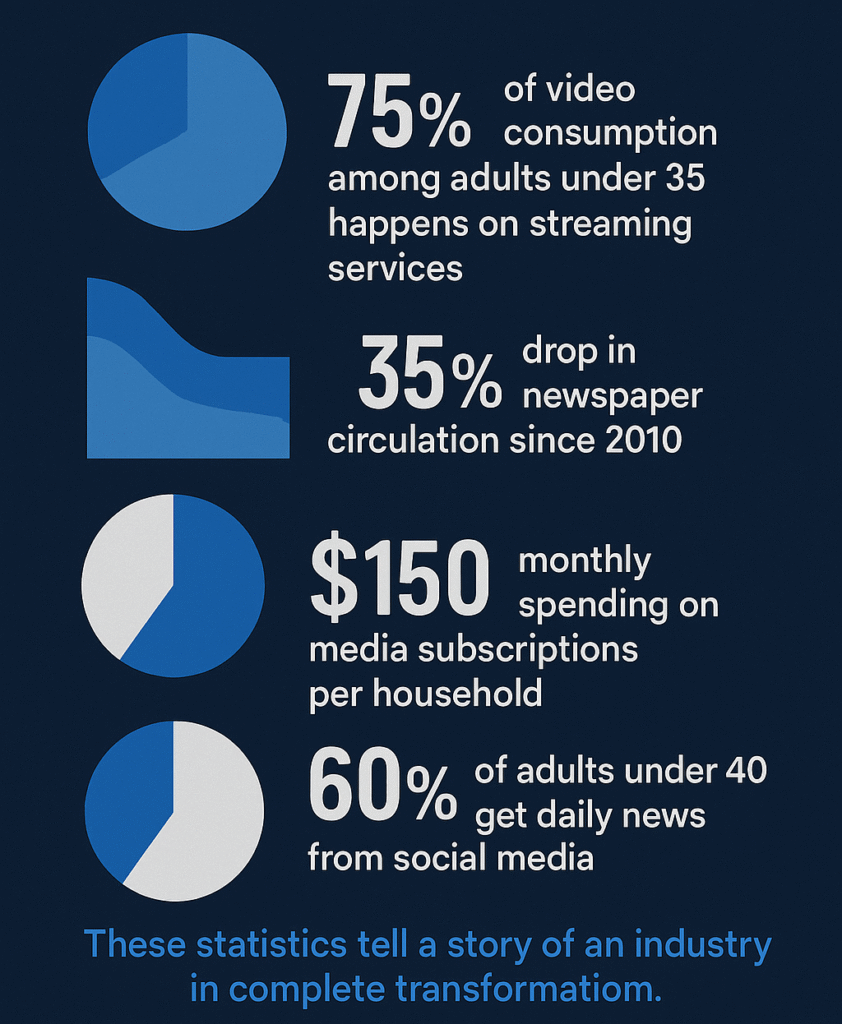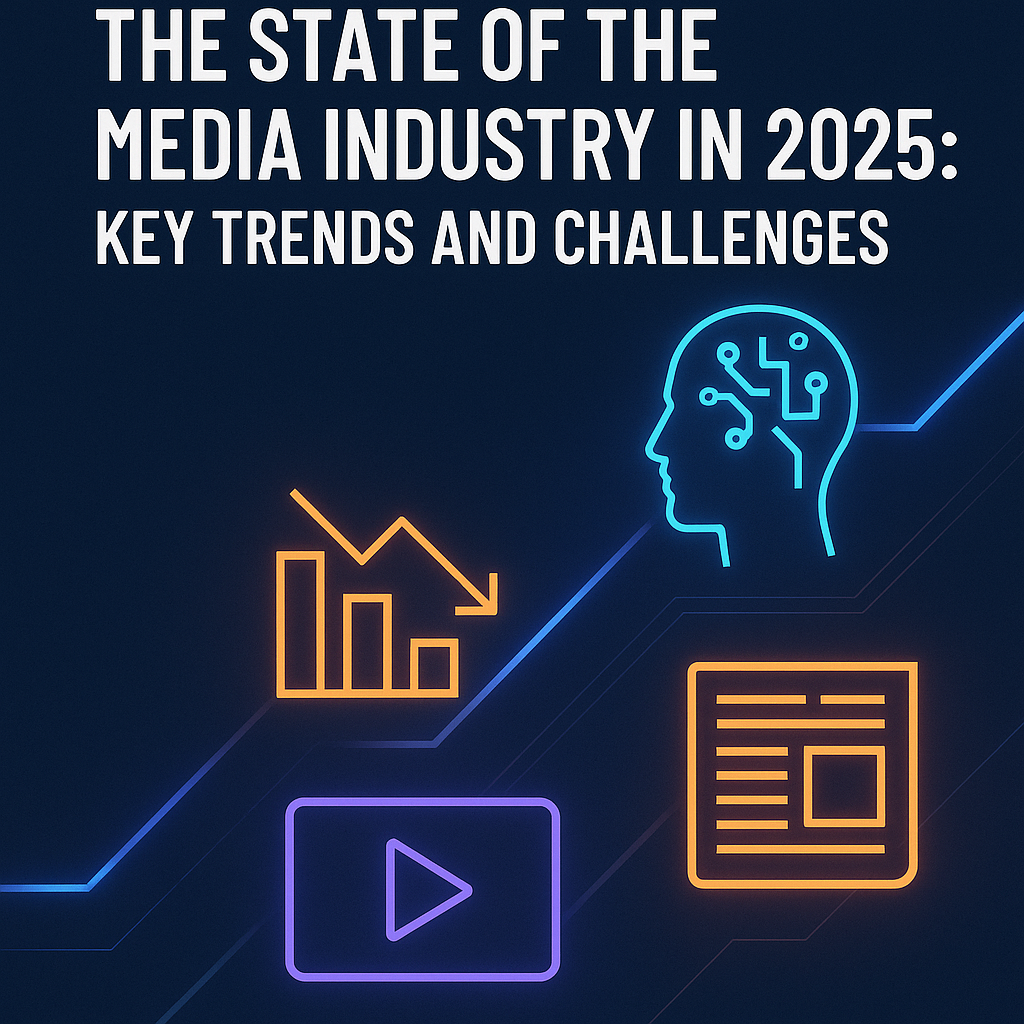The media industry stands at a crossroads in 2025, facing unprecedented challenges that could reshape how we consume content forever.
From the explosive growth of artificial intelligence to the collapse of traditional advertising models, media companies are scrambling to adapt or risk becoming obsolete.
If you work in media, create content, or simply want to understand where entertainment and news are heading, this analysis reveals the game-changing trends that will define the state of the media industry this year.
Table of Contents
The Numbers Don’t Lie

Here’s what’s happening right now:
- 80% of video consumption among adults under 35 happens on streaming services
- 75% drop in newspaper circulation since 2010
- Less than 30% of American households will have cable by the end of 2025
- $150 monthly spending on media subscriptions per household
- 60% of adults under 40 get daily news from social media
These statistics tell a story of an industry in complete transformation.
AI is Taking Over Content Creation (And It’s Happening Fast)
The Trend: Artificial intelligence has moved from science fiction to daily reality in media production. Major studios now use AI for everything from script analysis to visual effects generation, cutting production costs by 40% in some cases.
News organizations are leveraging AI to process breaking news faster than ever before. Reuters has implemented AI systems that can generate initial news reports within minutes of events occurring, allowing human journalists to focus on deeper analysis and investigation.
What This Means for You:
- Independent filmmakers can create Hollywood-level visual effects on tiny budgets
- Podcasters use AI-generated music and sound effects
- Streaming platforms predict what you want to watch with 90% accuracy
- Small media companies can now compete with industry giants
The Challenge: Jobs Are Disappearing Faster Than They’re Being Created
Here’s the reality nobody wants to talk about:
Traditional media jobs are vanishing faster than new AI-collaborative roles are appearing. Thousands of editors, writers, and production assistants find themselves without clear career paths.
The biggest problem? Audiences are becoming increasingly sceptical of content authenticity. When you can’t tell if a news article was written by a human or AI, trust breaks down completely.
Media companies must invest heavily in training staff to work alongside AI tools while maintaining the creative integrity that audiences expect.
The Streaming Wars Are Getting Brutal
The Trend: Netflix, Disney+, Amazon Prime, and newer players are spending billions on exclusive content while traditional cable subscriptions continue their steep decline.
This creates opportunities for content creators, but competition for viewer attention has never been fiercer. 70% of viewers decide whether to continue a series based on their first episode experience.
International Content is Winning: Korean dramas, Spanish series, and Bollywood productions are finding massive global audiences. This globalization creates new revenue streams for companies willing to invest in diverse storytelling.
The Challenge: Everyone’s Bleeding Money
The streaming wars have created an unsustainable arms race in content spending. Major platforms are burning through billions annually on original programming, with many shows failing to generate sufficient viewership to justify production costs.
The harsh reality:
- Market saturation means even excellent shows disappear without notice
- Platforms are forced to raise subscription prices, creating consumer backlash
- Content discovery has become nearly impossible for viewers
- Profit margins are getting tighter every quarter
Social Media Has Become the New TV News
The Trend: Over 60% of adults under 40 now get their daily news primarily from social media platforms rather than traditional news websites or television broadcasts.
TikTok, Instagram, and Twitter have evolved into news distribution networks. News organizations must now create content specifically optimized for each platform’s algorithm and user behavior patterns.
Why This Matters:
- Short-form video explaining complex news stories is now essential
- Influencer journalists often have larger audiences than traditional news anchors
- Digital-native journalists cover stories ignored by mainstream media
The Challenge: Fake News is Everywhere
The shift to social media news consumption has created an unprecedented misinformation crisis that threatens informed democracy.
Unlike traditional media with editorial oversight, social platforms allow anyone to publish news-like content without verification. This leads to rapid spread of false information that can influence elections, public health decisions, and social stability.
The scary part: The Associated Press has expanded its fact-checking operations by 200% since 2023, but they’re still losing the battle against misinformation.
Traditional news organizations struggle to compete with sensationalized content that performs better on social algorithms. The platforms reward engagement over accuracy, forcing legitimate journalists to compromise editorial standards or risk losing audiences.
Podcasts Are Finally Making Real Money
The Trend: In 2025, podcast advertising revenue is projected to exceed traditional radio advertising for the first time. This is driven by precise audience targeting and higher engagement rates.
What’s Working:
- Exclusive podcast content has become a major competitive advantage for streaming platforms
- Interactive podcasting with live audience participation is growing rapidly
- International podcast markets (especially Asia and Latin America) are exploding
- Podcast-to-video adaptations are expanding monetisation opportunities
Success Stories: Spotify’s investment in high-profile podcast exclusives has generated significant subscriber growth, while Amazon’s podcast offerings integrate seamlessly with its broader entertainment ecosystem.
Gaming and Movies Are Becoming the Same Thing
The Trend: The boundary between gaming and traditional media continues to blur, creating entirely new entertainment categories that combine interactive gameplay with narrative storytelling.
What’s Happening:
- Major film studios are developing interactive movies where viewers make choices affecting plot outcomes
- Esports has matured into a legitimate media category with broadcast rights and sponsorship deals
- Virtual reality and augmented reality are finding mainstream applications
- Platforms like Roblox and Fortnite host virtual concerts and movie screenings
The Numbers: Esports audience numbers now rival traditional sports, making it attractive for advertisers seeking engaged viewers across all age groups.
Everyone’s Tired of Paying for Subscriptions
The Trend: The average American household now subscribes to 4.5 different streaming services, spending over $150 monthly on media subscriptions. This unsustainable growth has reached a ceiling.
What Companies Are Doing:
- Bundle services are making a comeback (think Disney+ + Hulu + ESPN+)
- Micropayment systems for individual content pieces are gaining traction
- Ad-supported free tiers are becoming standard across streaming platforms
The Challenge: Customers Are Cancelling Faster Than Ever
Subscription fatigue has created a massive churn problem, with average monthly cancellation rates reaching 15% across streaming platforms.
The brutal truth:
- Consumers subscribe only to watch specific content, then immediately cancel
- Revenue forecasting has become nearly impossible
- Companies face the impossible choice between raising prices and losing money
- Many platforms are discovering their content isn’t valuable enough to justify premium pricing
Big Companies Are Eating the Small Ones
The Trend: Rising interest rates, declining advertising revenues, and subscription market saturation are forcing smaller media companies to seek buyers or face closure. Major conglomerates are acquiring struggling competitors at discounted prices.
What This Means: When fewer companies control more media outlets, the range of perspectives and voices available to audiences naturally narrows. Independent journalism faces particular threats as local newspapers and speciality publications lack the resources to compete.
The Challenge: Governments Are Starting to Pay Attention
Government regulators worldwide are scrutinizing media mergers more closely, recognizing the threat to democratic discourse when too few entities control information flow.
The problem for companies: They need to grow large enough to compete effectively while avoiding regulatory intervention. This requires sophisticated legal strategies and often results in complex ownership arrangements that obscure true market concentration.
The Creator Economy is Changing Everything
The Trend: Independent content creators have fundamentally altered how media industry professionals build careers. Traditional employment with established media companies is no longer the only path to success.
What’s Different:
- Creators can build substantial audiences and revenue streams through YouTube, Substack, and Patreon
- This shift has created a new class of media entrepreneurs who own their audiences directly
- Success requires mastering content creation, business management, marketing, and audience development
The Challenge: One Algorithm Change Can Destroy Your Career
Content creators face the constant threat of algorithm changes that can destroy their reach overnight.
The harsh reality:
- Platforms like TikTok, Instagram, and YouTube regularly modify recommendation systems without warning
- Even successful creators can lose significant portions of their audiences instantly
- Platform policies can change payment structures or ban creators entirely
- The pressure to constantly produce content has led to widespread creator burnout
Many creators are diversifying across multiple platforms and building direct audience relationships to reduce this dependency, but the effort required often detracts from content creation itself.
Privacy Laws Are Changing Everything
The Trend: Increasingly strict data privacy regulations are reshaping how media companies collect and use audience information in 2025. The expansion of GDPR-style legislation across multiple countries has forced media organizations to completely reimagine their data collection strategies.
What’s Changing:
- First-party data collection has become crucial as third-party cookies disappear completely
- Organisations are investing in direct audience relationships through newsletters, apps, and loyalty programs
- Privacy-preserving analytics technologies enable understanding audience behaviour without compromising individual privacy
- Transparency in data usage has become a competitive advantage
The Bottom Line: Media companies that clearly communicate how they use audience data and provide genuine value in exchange are building stronger customer relationships and higher engagement rates.
What Does This All Mean?
The state of the media industry in 2025 reveals an ecosystem in rapid transformation, where adaptability and innovation determine survival.
The Winners Share These Traits:
- They embrace technological change while maintaining focus on quality content
- They prioritise direct audience engagement over platform dependency
- They maintain flexibility in their business models
- They invest in new technologies early but don’t abandon creative excellence
The Reality Check: Content quality remains the ultimate differentiator despite technological advances. Audiences have more choices than ever before, making compelling storytelling and professional production values essential for cutting through the noise.
The Opportunity: International expansion presents the greatest growth opportunity for media companies in 2025. As domestic markets become saturated, organisations that can successfully adapt their content for global audiences while respecting cultural differences will capture the most valuable growth opportunities.
Frequently Asked Questions
What are the biggest challenges facing the media industry in 2025?
The primary challenges include subscription fatigue among consumers, intense competition from both traditional and tech companies, adapting to AI-driven content creation, navigating complex data privacy regulations, and maintaining profitability while investing in new technologies and platforms.
How is artificial intelligence changing media production?
AI is revolutionising media production by automating editing tasks, generating visual effects, personalising content recommendations, creating initial news reports, and enabling smaller companies to produce professional-quality content. However, it’s augmenting rather than replacing human creativity and oversight.
Will traditional television completely disappear?
While traditional cable subscriptions are declining rapidly, television as a medium is evolving rather than disappearing. Smart TVs, streaming platforms, and on-demand viewing are replacing scheduled programming, but large-screen viewing experiences remain popular for certain content types.
What role do social media platforms play in news consumption?
Social media platforms have become primary news sources for younger demographics, with over 60% of adults under 40 getting daily news from these platforms. This shift is forcing traditional news organizations to adapt their content strategies and distribution methods significantly.
How are media companies addressing subscription fatigue?
Companies are responding with bundled services, ad-supported free tiers, micropayment options for individual content pieces, and more flexible subscription models. The focus is shifting toward providing clear value and allowing consumers to customise their media consumption expenses.
